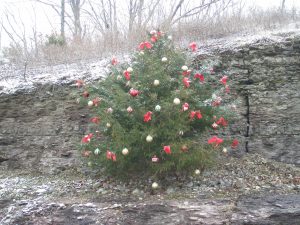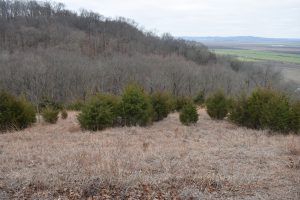History of the Beloved Christmas Tree
Real or artificial, tiny or tall, inside or outside, in homes, schools, stores or churches -they are everywhere we turn. What is the origin of the Christmas tree?
Evergreens have been utilized to celebrate winter festivals both Christian and pagan for years. Just as we decorate our homes for the holidays with pine, spruce and fir trees, ancient peoples hung evergreen boughs over their doors and windows. In many countries, it was thought to ward off witches, ghosts, evil spirits or illness.

An Eastern Red Cedar in the bluffs is decorated for Christmas. Photo courtesy Joann Fricke
Many ancient people believed that the sun was a god and that winter came every year because the sun god had become sick and weak. They celebrated the winter solstice because it meant that at last the sun god would begin to get well. Evergreen boughs reminded them of all the green plants that would grow again when the sun god was strong and summer would return.
Early Romans marked the solstice with a feast call the Saturnalia, in honor of Saturn, the god of agriculture. The Romans knew that the solstice meant that soon farms and orchards would be green and fruitful. To mark the occasion, they decorated their homes and temples with evergreen boughs. In northern Europe, the mysterious Druids also decorated their temples with evergreen boughs as a symbol of everlasting life.
Germany has been credited with the origin of the modern Christmas tree tradition beginning in the 16th century when devout Christians brought decorated trees into their homes. Martin Luther, trying to bring the brilliance of stars twinkling among the evergreens inside, first added lighted candles to the Christmas tree. This tradition, as you may have guessed, resulted in many fires.
Another legend is that people in Germany combined two customs that had been practiced in different countries around the globe. The Paradise tree (a fir decorated with apples) represented the Tree of Knowledge in the Garden of Eden. The Christmas Light, a small, pyramid-like wooden frame, usually decorated with glass balls, tinsel and a candle on top, was a symbol of the birth of Christ as the Light of the World. Changing the tree’s apples to tinsel balls and cookies, and combining this new tree with the Light placed on top, the Germans created the tree that many of us know today.
The first recorded Christmas tree on display in America was in the 1830’s by German settlers in Pennsylvania. In 1846, the popular royals, Queen Victoria and her German husband Prince Albert, were sketched in a London periodical standing around a Christmas tree with their children, thus making it fashionable in Britain, Canada and the east coast of America.
Apples, berries, nuts, cookies and other homemade ornaments were used initially to decorate the trees. Christmas trees were first sold commercially in the U,S. about 1850. By the 1890’s, Christmas ornaments were arriving in the U.S. from Germany and Christmas tree popularity was on the rise. Europeans used small trees, about four feet in height, while Americans liked their Christmas trees to reach from floor to ceiling. Popcorn strung with berries and other natural objects was favored. The popular shiny tinsel was once banned by the government because it contained lead but it is now made of plastic.
Thomas Edison’s associates are credited with the idea of electric light use on Christmas trees. In 1903, the first commercial lights were available for $12 for a strand of 24 lights, which was too expensive for the masses. However, someone had the wonderful idea to rent Christmas tree lights for a much cheaper price allowing them to be used by everyone.
The best-selling natural trees are Scotch Pine, Douglas Fir, Fraser Fir, Balsam Fir and White Pine. Eastern Red Cedar are commonly used in the south. The have a natural pyramid shape where they grow naturally and are affordable. Locally, some may remember driving to the country to cut down a cedar tree, which is actually a juniper, to use as a Christmas tree. The smell they made in the house was heavenly, but they were the devil to decorate–with the needle-like leaves poking your fingers as you tried to hang ornaments.

Eastern red cedars will take over a hill prairie if stewardship is lacking. Regular prescribed fire is one way to keep them in check. Photo courtesy Joann Fricke
Eastern Red Cedars will take over a hill prairie if stewardship is lacking. While a native species, they are considered invasive if allowed to multiply unchecked. A hill prairie in the bluffs near Valmeyer looked more like a Christmas tree farm prior to restoration. Cedars are susceptible to fire so prescribed fire is an excellent way to manage an intrusion into a hill prairie. Also, if the trunk is cut below the lowest branch, a cedar will not grow back, making the use of herbicide unnecessary.
The first artificial Christmas trees were developed in Germany during the 19th century. These “trees” were made using goose feathers that were dyed green. Developed in the 1880’s, the feather trees became increasingly popular during the early part of the 20th century, eventually making their way to the United States. In the 1930’s, brush bristled Christmas trees made their debut. Aluminum Christmas trees were first manufactured in the late 1950’s. Most artificial Christmas trees are now made from PVC plastic and are pre-lit, saving one the trouble of untangling the multiple strands of lights that were haphazardly deposited in the storage box the previous year.
Some facts about our beloved Christmas trees:
The tallest living Christmas tree is believed to be a Douglas fir tree, 122 feet tall and 91 years old, in Woodinville, WA.
Christmas trees are grown in all 50 U.S. states, including Alaska and Hawaii. The top producing states are California, Oregon, Michigan, Wisconsin, Pennsylvania and North Carolina.
There are 34 to 36 million trees produced each year. They take 6 to 8 years to mature.
100,000 people are employed in the Christmas tree industry.
In 1912, the first community Christmas tree in the U.S. was erected in New York City.
The Rockefeller Center Christmas tree tradition began in 1933.
Franklin Pierce, our 14th President, had the first Christmas tree in the White House.
In 1923, President Calvin Coolidge held the first lighting of the National Christmas tree.
Teddy Roosevelt banned a tree in the White House for environmental reasons.
In 1963 the National Tree was not lit until December 22 after 30 days of mourning for President Kennedy.
In 1979, only the top ornament was lighted on the National Christmas tree to honor the American hostages in Iran.
Real or artificial, colored lights or white lights, tiny or tall, we hope you enjoy the tradition that celebrates the new season of life to come.
CLIFFTOP, a local nonprofit organization, is focused on preserving and protecting area blufflands.
A version of this article appeared in the December 21, 2018 edition of the Monroe County Independent.
© 2018 all content rights reserved Clifftop NFP.
Comments are currently closed.
